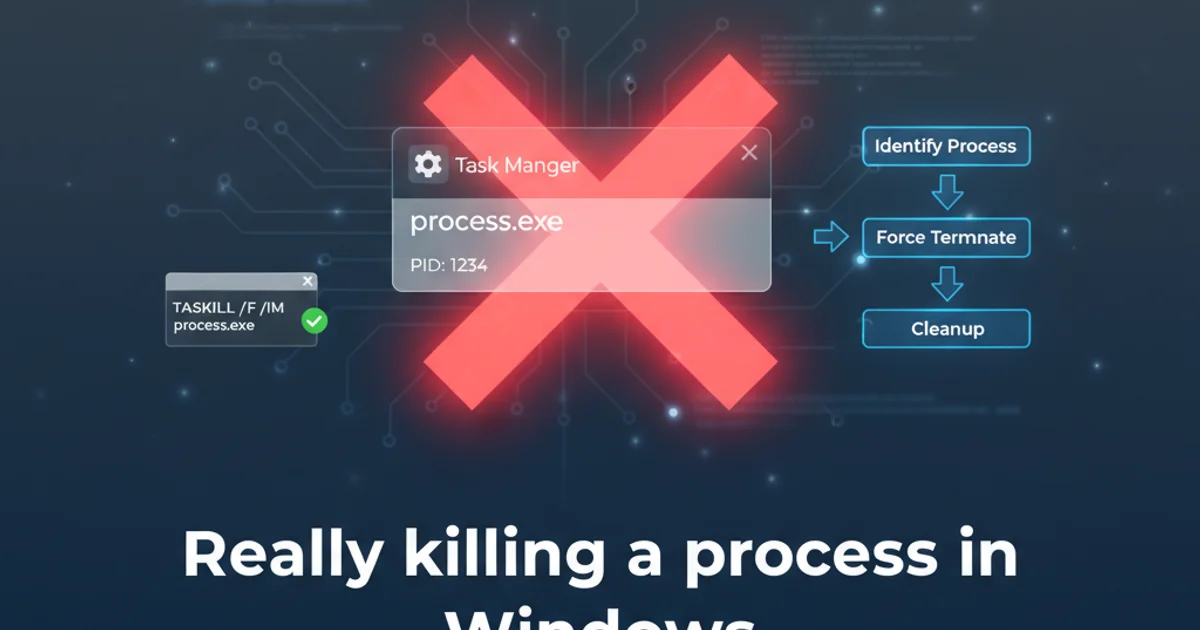Really killing a process in Windows
Categories:
Really Killing a Process in Windows: A Comprehensive Guide

Learn how to effectively terminate stubborn processes in Windows using various command-line tools and the Task Manager, ensuring system stability and resource management.
Windows processes can sometimes become unresponsive or consume excessive resources, leading to system slowdowns or freezes. While the Task Manager is often the first tool users reach for, some processes are notoriously difficult to terminate. This article delves into advanced methods for truly killing a process in Windows, ensuring it doesn't linger in the background or restart unexpectedly.
Understanding Process Termination
When you attempt to close an application or end a task, Windows typically sends a termination signal to the process. A well-behaved application will receive this signal, save its state, and shut down gracefully. However, a misbehaving process might ignore this signal, be stuck in a loop, or have open handles that prevent it from closing. In such cases, a more forceful approach is required. Understanding the difference between a graceful shutdown and a forced termination is crucial for maintaining system health.
flowchart TD
A[User Initiates Termination] --> B{Process Responds?}
B -->|Yes| C[Graceful Shutdown]
B -->|No| D[Process Unresponsive]
D --> E{Attempt Forceful Termination}
E --> F[Process Terminated]
E --> G[Process Persists]
G --> H[Advanced Termination Methods]Process Termination Flow
Method 1: Task Manager (The Basics and Beyond)
The Task Manager (taskmgr.exe) is your primary tool for managing processes. While 'End task' often works, sometimes you need to go deeper. The 'Details' tab provides more information and options.
1. Open Task Manager
Press Ctrl + Shift + Esc or Ctrl + Alt + Del and select 'Task Manager'.
2. Identify the Process
Navigate to the 'Processes' tab. If the process is listed by its application name, select it and click 'End task'. If it's a background process or service, you might need to check the 'Details' tab.
3. Use 'End Task' (Standard)
In the 'Processes' tab, select the application and click 'End task'. This sends a polite termination request.
4. Use 'End Task' (Details Tab)
If the process persists, go to the 'Details' tab. Find the process by its executable name (e.g., chrome.exe, notepad.exe). Right-click on it and select 'End task'. This is a more forceful termination than from the 'Processes' tab.
5. End Process Tree
If the process has child processes (e.g., a browser with multiple tabs), right-click the main process in the 'Details' tab and choose 'End process tree'. This attempts to terminate the selected process and all processes it launched.
Method 2: Command Prompt (Taskkill)
For more control and scripting capabilities, the taskkill command-line utility is invaluable. It allows you to terminate processes by name or Process ID (PID).
tasklist
taskkill /IM "processname.exe" /F
taskkill /PID 1234 /F
Basic taskkill commands
Let's break down the taskkill command options:
/IM
Specifies the image name (executable file name) of the process to be terminated. Wildcards (*) can be used.
/PID
Specifies the Process ID (PID) of the process to be terminated. You can find the PID using tasklist or Task Manager's 'Details' tab.
/F
Forces termination of the process. This is often necessary for stubborn processes.
/T
Terminates the specified process and any child processes it started (process tree).
REM Find the PID of a process
tasklist | findstr /I "chrome.exe"
REM Kill a process by name forcefully
taskkill /IM "chrome.exe" /F
REM Kill a process by PID forcefully
taskkill /PID 5432 /F
REM Kill a process and its children forcefully
taskkill /IM "myprogram.exe" /T /F
Advanced taskkill examples
taskkill to ensure you have the necessary permissions to terminate system-level or protected processes.Method 3: PowerShell (Stop-Process)
PowerShell offers a more robust and object-oriented way to manage processes with the Stop-Process cmdlet. It provides similar functionality to taskkill but with more flexibility for scripting.
Get-Process -Name "processname" | Stop-Process -Force
Stop-Process -Id 1234 -Force
Stop-Process -Name "*chrome*" -Force
Basic Stop-Process commands
Key parameters for Stop-Process:
-Name
Specifies the name of the process to stop. Wildcards are supported.
-Id
Specifies the Process ID (PID) of the process to stop.
-Force
Suppresses confirmation prompts and forces the termination.
-PassThru
Returns the process object that was stopped. Useful for verification.
Get-Process -Name "notepad" | Stop-Process -Force -PassThru
# Find processes by partial name and kill them
Get-Process -Name "*firefox*" | Stop-Process -Force
# Kill all processes owned by a specific user (requires admin rights)
Get-Process | Where-Object {$_.Owner -eq "DOMAIN\username"} | Stop-Process -Force
Advanced Stop-Process examples
Get-Process cmdlet is very powerful for filtering and identifying processes before you attempt to stop them. You can filter by CPU usage, memory, owner, and more.